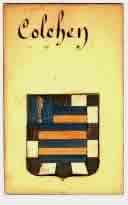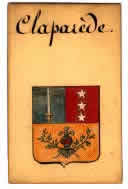The Language of Heraldry
Contrary to popular opinion, coats of arms were rarely recorded visually, that is to say in the form of a picture or drawing. And so, today it is often up to the Heraldic Artist to render arms from a written descriptions. As a result, there is no absolutely correct way to draw or paint a lion rampant, for example; however, the size, proportions portions and positioning of the lion do follow a precise format that is still observed today.
The language used to describe the heraldic tinctures (metals, colors and furs), ordinaries and devices developed to quite a concise but common language throughout Europe by the sixteenth century. While many countries often recorded the arms in their own language, the structure was for the most part universal (generally the tincture of the surface of the shield is provided first, followed by ordinaries and devices or emblazons and their colors. Thus the expression " Ar... a lion ramp. sa..." can be translated to "Argent, a lion rampant, sable" or a silver shield with a black lion rampant. As you can see, the heraldic description is neither French, Latin or English but a mixture of many languages that has developed over the centuries.
The Heraldic Artist
Even today, the heraldic artist has a formidable challenge. Whilst he may enjoy considerable freedom, within certain limits, the objects in the arms and crest, their colors, disposition and symmetry may not be altered. Unfortunately, attempts by layman and even some commercial graphic artists often result in some classic mistakes or incongruities. Although a "lion rampant, gules, armed and langued, azure" can be fat, thin, hairy or bald, happy or angry, it must be in the rampant position, colored red and the tongue and claws of blue.
Obviously, its resemblance to a real lion is obscure. Historically, the heraldic artists' only choice was often to render an animal as he thought it would appear. Therefore, many modern artists portray their lions with the claws and head of a similar size as people traditionally believed that the lion's claws were just as important as the lion's head.
The martlet is another example of an apparent mistake by heraldic artists. Martlets are traditionally drawn without legs but tufts of feathers. The real reason for this apparent mistake is unclear, but some say legless birds like these were found in the Holy Land at the time of the Crusades, others say that the birds like these followed ships endlessly for scraps of food and as they never seemed to land, they had no legs. Whatever, the real reason, it matters not as martlets are always correctly drawn without legs, even as the mark of cadency for a fourth son.
Heraldry through the Ages
It is generally believed that in its beginning, heraldry originally had a strong military purpose. Men in armor were very difficult to recognize. For example, William the Conqueror had to remove his helmet in the midst of the battle of Hastings in order to prove himself to his followers who thought he was killed. Thus the need for identification or distinction from one's enemies became essential, especially when the closed helmet was developed.
By the 13th century, the rules and the terminology that we know today started to form. Specialists in the field became known as heralds. They were appointed but it was their task to set forth and document all arms in existence to insure that duplication did not occur. Blazon, a heraldic term, originated with the custom of blowing a trumpet to announce the arrival of a knight at the joust or tournament. The blast was answered by the heralds who described and explained aloud the arms borne by the knight.
In ancient times, crests and mottoes may have been used by all, but with the passing of the centuries some have been omitted or forgotten.
With the suppression of private armies, and the gradual disappearance in the 16th century of both tournaments and closed helmets, the sporting and military uses of heraldry became less important and it became rather a decorative art. Coats of arms were carved over doorways, woven on tapestries, placed in stained glass windows and engraved on silver.
Many heralds attempted to "collect" as many arms for their published works as they could, an arduous task obviously limited by the inability to travel or communicate over vast regions. In addition, through the ages, vast numbers of heraldic records have been lost and many legitimate coats of arms cannot be found in reference books of today.
Supporters
Supporters are traditionally beasts, birds, monsters, human or mythical animals that stand on either side and support the coat of arms. Today, many civic and municipal coats of arms have such supporters, but their use is mostly restricted to the above or for people who have achieved much notoriety. Family coats of arms do not show supporters.
Heraldry today
The term "heraldry" often necessitates many people to check their dictionary for the meaning, but evidence of heraldic art is everywhere today. If one takes a moment to reflect many of the coats of arms or heraldic shields seen in the normal course of a day, it becomes quite astounding.
The obvious national, provincial or state coat of arms usually come to mind first. But on closer inspection, most schools, colleges and universities, cities or towns, military groups or police forces, and even many corporations use coats of arms today as a proud symbol of their heritage and comradeship.
The world of sport is another example of modern heraldry at its best with most ball clubs, leagues (the National Football League and the National Hockey League both have a shield as their basis of their design), associations or groups having an heraldic design as their emblem.
In fact, purists believe that most logos or emblems are simply a hybrid of ancient heraldic seals or emblazons.
The world of law is steeped in the tradition of heraldry. Today, most legal documents still require a red seal to be affixed. This tradition dates back to medieval times when the knight's seal was used with sealing wax to ensure a document was legitimate and bona fide. In short, heraldry is very much a part of our lives today, whether it appears in it's most conventional art form, or as an emblem or corporate design.
- ^ Swyrich, Archive materials





